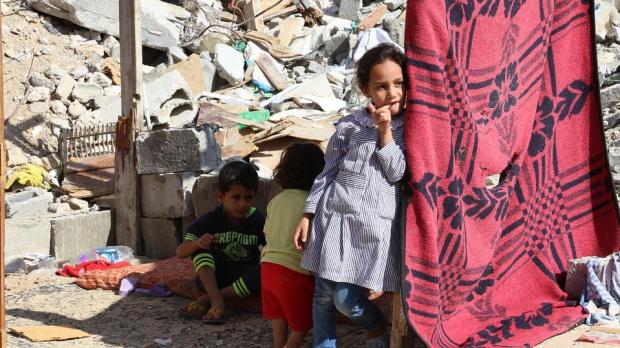It was only one night, but 34 year-old Hilary DuBose remembers every moment of the bombs raining down. She was in Gaza, where she goes every couple of weeks for her job as Head of Programs for Jerusalem, West Bank, and Gaza for Catholic Relief Services (CRS). During the 2014 conflict, she went in during a ceasefire and while there, the ceasefire was broken and she was trapped overnight.
“I didn’t feel afraid for my own life because I was in a building that Israel knows is in a UN area. But you know what the sound of the bombs means… that someone somewhere is losing their home, possibly their life,” says DuBose, who originally hails from Oregon. “I’d never been in that situation before and my body just shut down, a catatonic state of just getting through the night. For my colleagues and friends in Gaza, that was their 51st night of that. And I had one. But it really impacted me.”
In spite of that experience, DuBose, who is based in Jerusalem, says her trips into Gaza are the highlight of her work—she loves it there. But she knows people may have a hard time understanding that.
“Gaza is an unknown place in the world. If you ask people what they associate with Gaza, I think the first thing they’d say is ‘terrorism.’ I understand that,” she says. “But we’re dealing with communities that are caught in a very difficult position.”
DuBose points out that children in Gaza who are 8 years old have already been through three wars. And the World Bank reported last year that Gaza has the world’s highest unemployment rate—almost 43 percent, with youth unemployment at 60 percent. “It’s a chronic crisis because people don’t have income,” DuBose explains. She and her team help to address this through short-term job creation programs, in addition to their assistance with emergency response and preparedness.
But despite Gaza’s deeply entrenched problems and the hardships she witnesses, DuBose says what touches her most when she goes to Gaza is the “unquenchable spirit for life” there and the hospitality of the people.
“Gaza is well-known for generosity and kindness,” she says. “Any time you visit someone, they welcome you with open arms—whether you’re a stranger, no matter where you’re from. And they have this wonderful sense of humor.”
DuBose says she saw this in the aftermath of the 2014 conflict when more than 1,100 homes were destroyed. Among its projects in Gaza, CRS builds wooden shelters, designed to last a minimum of five years, and so far the team has built about 500. “Every single one of those shelter recipients has a compelling story,” says DuBose. But a recent story stands out to her, involving a family of six — a husband, a wife, and their four children. In the conflict, the family had to move to a “collective center,” a school that opens up for displaced people, where they stayed for about a month, with many others, sharing a few bathrooms and no showers. They didn’t know what had happened to their home at the time because they were afraid to go anywhere.
“They had worked their whole lives to save up and build their home, and had just finished constructing it in 2005,” relates DuBose. “When they came back, they discovered it had been completely destroyed. Not only that, but this was their family ancestral land with many ancient olive trees —and every single tree had been ripped up by its roots. They had lost their home and their livelihood.”
This family found out about the shelters, signed up for the project, and the CRS team was able to build one for them quickly, on their own land. “They had been living on their land at that point—as there was no where else to go—and had essentially built a chicken coop for themselves, a makeshift shelter cobbled together with random pieces of material they could find like wood, corrugated metal, and cardboard,” says DuBose, who keenly remembers what they told her after they spent their first night in the new shelter. “When they woke up, their son said to them, ‘This is first night I’ve been able to fall asleep since the war without worrying, with spending half the night up with anxiety.'”
DuBose loves this story because it illustrates the power of a good shelter. “You can build something out of brick or out of wood, but it’s not the construction, it’s the peace of mind, the security, that a good shelter brings,” she says.
After nearly three years in the Holy Land, DuBose takes seriously the responsibility to help hard-working families who have built something for themselves over many years and then had it taken away. “The spirt of the people is so touching and really inspires me, and I feel safe there because Gazans are happy I’m there, to stand in solidarity with them, to support them.”
Catholic Relief Services (CRS) has been in the Holy Land for over 50 years. Its programs have changed over time as it seeks to respond to the needs there at any given time. Currently the biggest need is in Gaza as people continue to recover from the 2014 military operation. CRS was recently awarded a $50 million grant from USAID for “Envision Gaza 2020,” to use for emergency response and preparedness, as well as job creation over the next five years.
Check out Aleteia’s recent article about an American foreign aid worker’s experience in Iraq.

